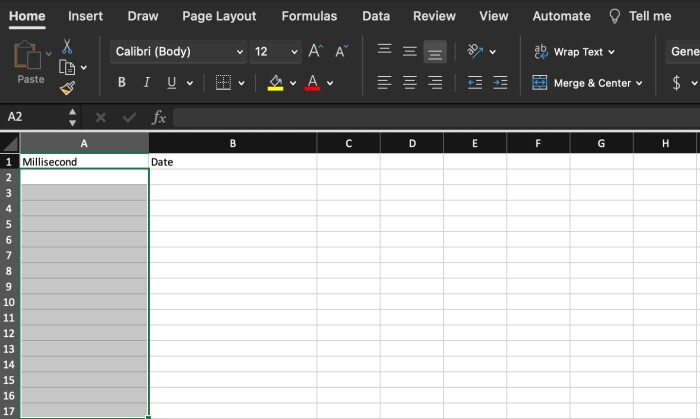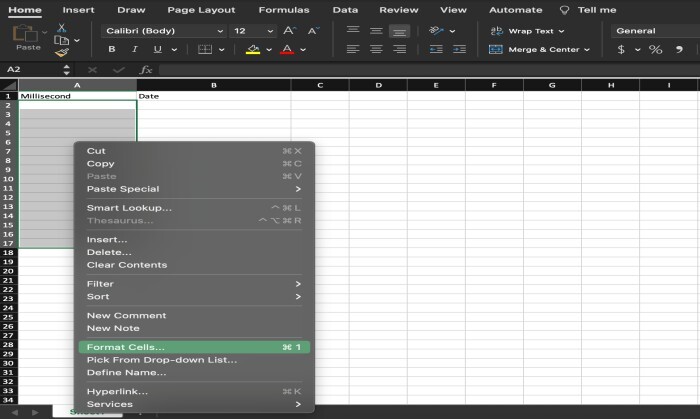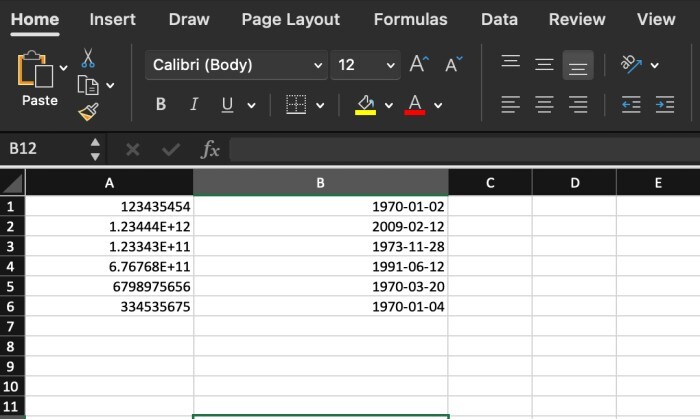
 Data Structure
Data Structure Networking
Networking RDBMS
RDBMS Operating System
Operating System Java
Java MS Excel
MS Excel iOS
iOS HTML
HTML CSS
CSS Android
Android Python
Python C Programming
C Programming C++
C++ C#
C# MongoDB
MongoDB MySQL
MySQL Javascript
Javascript PHP
PHP
- Selected Reading
- UPSC IAS Exams Notes
- Developer's Best Practices
- Questions and Answers
- Effective Resume Writing
- HR Interview Questions
- Computer Glossary
- Who is Who
How to Quickly Convert Milliseconds to a Date in Excel?
Introduction
Excel's features for calculating dates and times are quite comprehensive, enabling users to do tasks as diverse as parsing out individual components of a date and determining local time in many time zones. Excel's in?built Date/Time function is able to make more sense of timestamp data down to the millisecond. This is because dates that are structured for human consumption make it simpler for bots to consume them. The millisecond value may be converted to a date format, which will make it much simpler to do analysis, manipulation, and computation based on dates. You will have no trouble converting milliseconds into a date format in Excel if you just follow the directions that are provided in this article and do what it says.
Excel makes it simple to modify both dates and times, and the accuracy of the information you're working with may be measured in milliseconds. Milliseconds may be converted into dates in order to make analysis and manipulation more straightforward. In addition to providing information that may be put to use, this simplifies the process of doing many computations that are dependent on dates. This tutorial will teach you how to quickly and easily convert milliseconds to a date format in Excel by using formulae and the date tools that are built into Excel. Your capability to evaluate the data will be much improved if you implement dates into your Excel process in the manner outlined in this article.
Achievement in both comprehending and communicating ideas
In conclusion, dates may be utilized for analysis and alteration of data when converted from milliseconds to a date format in Excel. This conversion allows dates to be shown in the appropriate manner. It enhances your power to analyze patterns and connections in your timestamp data, allowing you to make conclusions on information that is current at the moment they were made. Excel's capabilities enable you to get actionable insights from the timestamp data you have and assist you in making the most of those insights.
Why does it happen
Users of Excel often face the challenge of converting milliseconds to a date format. This is because timestamps may appear in so many diverse contexts and data sets. Milliseconds are a more precise unit of measurement than seconds, allowing for more precise timing to be achieved. To do computations, analyses, and comparisons that rely on dates in Excel, however, it is preferable to utilize date formats that are readable by humans.Excel's date and time functions will only accept dates in one of seven formats: the year, the month, the day, the hour, the minute, and the second. It is possible to convert the unprocessed numerical values of milliseconds into recognized dates, which will make working with them in Excel much simpler.
Method: Using a combination of formulas and Excel's date functions
Step 1:Set up your data.
Ensure that your millisecond values are in a column in Excel. For example, let's assume your millisecond values are in column A, starting from cell A2.

Step 2: Create a helper column for the date conversion.
Insert a new column next to your millisecond column. In this column, enter the following formula in the first cell (B2)
=DATE(1970,1,1)+TIME(0,0,0)+A2/1000/86400

This formula converts the millisecond value to the equivalent date by dividing it by 1000 (to convert milliseconds to seconds) and then by 86400 (the number of seconds in a day). The result is added to the date January 1, 1970 (the starting point for many timestamp systems).
Step 3: Format the helper column as a date
Select the entire helper column (column B) and apply the desired date format to display the dates correctly. Right?click on the column header, choose "Format Cells," and select the appropriate date format.

Step 4: Copy and paste as values (optional)
You may maintain the converted dates as plain numbers by copying the complete help column and pasting it as values. This will prevent the dates from being turned into a formula. You may copy the values from one column to another by right?clicking on the column you want to copy the values from, choosing "Copy," and then right?clicking on the column you want to paste the values into and selecting "Paste Values."
Convert millisecond values to dates
Excel's date functions, in conjunction with formulae, may be used to convert milliseconds to a date format. In order to analyze and manipulate timestamp data with more efficiency, follow the methods in this article to swiftly convert millisecond values to dates. If necessary, try pasting the converted dates as static numbers and remember to format them correctly. Using this approach, you'll have a much easier time manipulating your timestamp data and doing date?based analytics in Excel.
In order to deal with timestamp data in Excel, it is necessary to convert milliseconds to a date format. By converting the millisecond values to dates, you may then use dates in a wide variety of studies, computations, and comparisons.
The year, month, day, hour, minute, and second are the only valid date formats for Excel's date and time functions. Since timestamps are often expressed in milliseconds, formatting them as dates ensures they are compatible with Excel and its many date?related functions.
Establishing a reference point, such as the Unix epoch (January 1, 1970), and then completing computations to calculate the number of days, hours, minutes, and seconds since that reference point is required to convert milliseconds to a date. Excel's built?in formulae and functions may help you do this.
Conclusion
You may quickly alter your timestamp data by applying filters, searching, and more after you convert the milliseconds to a date format. Excel's date and time calculation capabilities are extensive, allowing you to accomplish anything from extracting specific parts of a date to calculating time zones. Communicating and understanding are both improved when dates are given in a human?readable format.
In conclusion, dates may be used for analysis and modification of data when converted from milliseconds to a date format in Excel. It improves your capability to investigate patterns and connections in your timestamp data, letting you base judgments on timely knowledge. Excel's features allow you to extract useful insights from your timestamp data and help you make the most of them.

